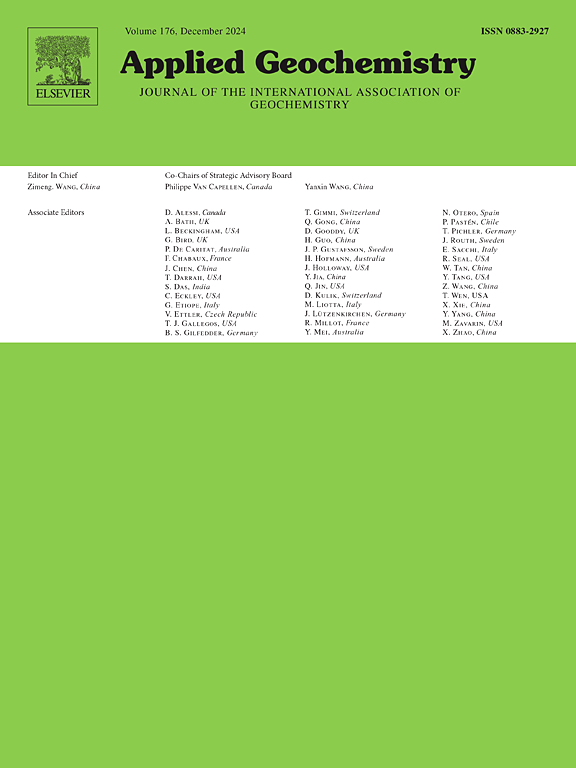Molecular simulation on Cs, Rb retention in Na/K-montmorillonite interlayer coupling clay swelling/collapse
IF 3.1
3区 地球科学
Q1 GEOCHEMISTRY & GEOPHYSICS
引用次数: 0
Abstract
A key issue about radioactive waste disposal and nuclear accident contamination control is the retention of radionuclides in clay minerals. The cation (Cs+, Rb+, Na+, K+) selectivity in montmorillonite (Mt) interlayers have not been quantitatively studied. This work employs classical molecular dynamics (CMD) to systematically investigate the interlayer structure, swelling properties, diffusion dynamics, and cation exchange processes. The selectivity of alkali ions within the interlayer space coupled with clay swelling/collapse under different water activity (aw) and cation activity, has been quantified. Both Cs-, Rb–Mt demonstrate a monolayer hydrate configuration as the most stable state. The mobility of intercalated species, as indicated by self-diffusion coefficients, exhibits a stepwise trend with increasing water content. The cationic selectivity within the interlayer follows the order Cs+ > Rb+ > K+ > Na + at aw = 1.0. The logarithm values of the selectivity coefficients for Cs/Rb relative to Na/K are as follows: logKc(Cs/K) = 0.73, logKc(Cs/Na) = 1.62, logKc(Rb/K) = 0.62, and logKc(Rb/Na) = 1.57 at aw = 1.0. A model correlating selectivity coefficients with water activity has been proposed. It is noted that Cs+ and Rb+ ions tend to accumulate within the interlayer as water activity decreases, and interlayer Rb+ competes with Cs+ for exchange positions at low water activity. These results can be used to quantify cationic partitioning during the remediation of radiocesium contamination in soil and weathering processes of sediments.
求助全文
约1分钟内获得全文
求助全文
来源期刊

Applied Geochemistry
地学-地球化学与地球物理
CiteScore
6.10
自引率
8.80%
发文量
272
审稿时长
65 days
期刊介绍:
Applied Geochemistry is an international journal devoted to publication of original research papers, rapid research communications and selected review papers in geochemistry and urban geochemistry which have some practical application to an aspect of human endeavour, such as the preservation of the environment, health, waste disposal and the search for resources. Papers on applications of inorganic, organic and isotope geochemistry and geochemical processes are therefore welcome provided they meet the main criterion. Spatial and temporal monitoring case studies are only of interest to our international readership if they present new ideas of broad application.
Topics covered include: (1) Environmental geochemistry (including natural and anthropogenic aspects, and protection and remediation strategies); (2) Hydrogeochemistry (surface and groundwater); (3) Medical (urban) geochemistry; (4) The search for energy resources (in particular unconventional oil and gas or emerging metal resources); (5) Energy exploitation (in particular geothermal energy and CCS); (6) Upgrading of energy and mineral resources where there is a direct geochemical application; and (7) Waste disposal, including nuclear waste disposal.
 求助内容:
求助内容: 应助结果提醒方式:
应助结果提醒方式:


